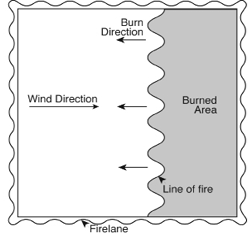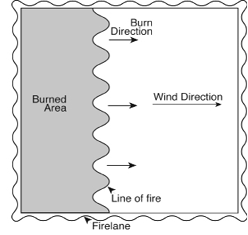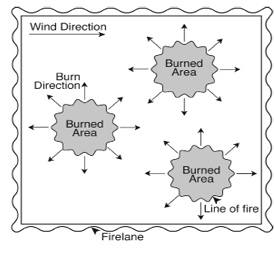Prescribed Burning in Southern Pine Forests: Fire Ecology, Techniques, and Uses for Wildlife Management
Prescribed burning is an important wildlife management tool used in our Southern pine forests. Because these forests regularly experienced burns in the past, vegetation and wildlife have adapted to fire and actually benefit from the effects of prescribed burning. Unfortunately, because of new pine management techniques and concerns about fire, many landowners are reluctant to use fire on their property. If done correctly, though, prescribed fire can be an effective, safe, and affordable management tool.
Benefits to Wildlife
If used properly, fire is one of the most beneficial and cost-effective wildlife habitat management tools available. For example, burning every 2 years maintains early stages of plant succession that bobwhite quail require. Fire reduces leaves/needles (litter) on the forest floor and exposes soil so bobwhites can easily find seeds. It creates open foraging and travel areas for hens with young chicks, and it encourages plants that provide food (insects and seeds) and cover for bobwhite. Fire also acts as fertilizer by removing vegetation and litter, returning many nutrients to the soil.
Burning is often conducted in late winter, although burning in other seasons may be conducted to accomplish specific habitat management objectives. To be most effective at providing a variety of plant types, divide the burnable acreage into three or four sections and burn one section each year. Having burned and unburned areas next to one another ensures food and cover is always available and in close proximity.
Wild turkey gain many of the same benefits from fire that bobwhites do. For turkey, it is best to burn before April to avoid nesting season, but burn less frequently (every 3 to 5 years) if turkey habitat is a specific objective. Fire creates and maintains forest openings in quality brood-rearing habitat 1 to 2 years after burning, and provides great nesting cover 3 to 4 years after burning.
Burning every 3 to 5 years increases white-tailed deer forage production and quality. It also maintains forage close to the ground, well within a deer’s reach. Good fawning cover is also produced 3 to 5 years following a burn. Burning top-kills hardwood brush and promotes sprouting of browse species. Winter burns are normally best for deer management.
Some of the species that suffer from the declining use of fire include bobwhite quail, wild turkey, white-tailed deer, gopher tortoise, and red-cockaded woodpecker. Populations of other birds, mammals, and reptiles, as well as amphibians, insects, and plants, also have declined in the absence of fire.
Important Prescribed Burn Techniques
Back fire. Back fires are set directly against the wind. This is one of the safest methods of prescribed burning and is recommended for beginning wildlife managers or where there are fire hazards, such as adjacent lands with high-danger fuels. Wind speed should be no more than 6 to 10 mph.

Head fire. Head fires are set with the wind direction and should only be used by experienced professionals under ideal fuel conditions. Head fires burn quickly, have a taller flame, and can kill even large pines if used improperly; however, head fires are very effective at maintaining early successional wildlife habitat. A strip head fire (lighting a head fire in small strips) can be effective while keeping the fire from becoming too hot and damaging pine trees.

Flank fire. Flank fires are often used when the fuel is relatively light. These fires are set by an individual or individuals walking into the wind and are relatively safe.

Spot fire. Ideally, spot fires are set at equidistant locations throughout the forest. These fires gradually expand until they join.

Expense and Equipment
Prescribed fire is one of the most economical wildlife management tools available. Burning costs vary with tract size, application method, manpower needed, equipment used, and timber/fuel conditions. Never burn without proper equipment to stop a fire if it were to escape a fire lane (for example, be sure to have a bulldozer equipped with a fire plow or a tractor and disk). Other required equipment includes drip torches, fuel (a 3:1 mix of diesel and gasoline), fire rakes, flappers, and water.
Consulting foresters, the Mississippi Forestry Commission (MFC), and other prescribed burn contractors provide this service. If you choose to hire someone for prescribed burning, costs average $25–30 per acre.
Prescribed Fire Landowner Liability
In Mississippi, landowners have the right to burn their property according to the Mississippi Prescribed Burning Act of 1992. However, there are a few requirements to minimize liability associated with prescribed burning:
- A certified prescribed burn manager must be on-site to supervise the burn.
- A written burn plan must be prepared and notarized before the burn day. If conditions do not meet parameters set forth in the burn plan, do not burn even if a burning permit is issued.
- A burning permit must be obtained from the MFC on the burn day. Contact your local MFC county or regional office to receive the permit. If conditions to burn are not favorable, the burn permit will not be granted.
- The burn must be in the public interest (i.e., timber or wildlife habitat improvement).
Steps to Conducting a Prescribed Burn on Your Property
- Become a certified prescribed burn manager. Landowners can become certified by completing a course offered through Mississippi State University and the MFC.
- Develop a burn plan for the area to be burned that includes desired ranges of wind speed and direction, temperature, humidity, and burning techniques to be used. Have the plan notarized at least 1 day before burning.
- Arrange for appropriate equipment and personnel to be present at the burn.
- Create fire lanes around the tract at least 2 weeks before the burn. Fire lanes should be cleared of all debris. Often, landowners maintain fire lanes with perennial green forages such as white clover.
- Notify your neighbors of your plan.
- On the burn day, recheck fire lanes, and recondition them if necessary.
- On the burn day, get a burn permit from the MFC.
- Conduct the burn according to your burn plan and burn permit (a permit is valid only for the day it is issued).
- While burning and after the burn, check all boundaries for escaped fire and to make sure all fires are extinguished when the burn is complete.
Publication 2283 (POD-03-20)
By Bronson Strickland, PhD, Extension Professor, Wildlife, Fisheries, & Aquaculture, and Scott Edwards and Bill Hamrick, Wildlife Biologists, Prescribed Burn Managers, Mississippi Department of Wildlife, Fisheries, & Parks.
Copyright 2020 by Mississippi State University. All rights reserved. This publication may be copied and distributed without alteration for nonprofit educational purposes provided that credit is given to the Mississippi State University Extension Service.
Produced by Agricultural Communications.
Mississippi State University is an equal opportunity institution. Discrimination in university employment, programs, or activities based on race, color, ethnicity, sex, pregnancy, religion, national origin, disability, age, sexual orientation, genetic information, status as a U.S. veteran, or any other status protected by applicable law is prohibited. Questions about equal opportunity programs or compliance should be directed to the Office of Compliance and Integrity, 56 Morgan Avenue, P.O. 6044, Mississippi State, MS 39762, (662) 325-5839.
Extension Service of Mississippi State University, cooperating with U.S. Department of Agriculture. Published in furtherance of Acts of Congress, May 8 and June 30, 1914. GARY B. JACKSON, Director
The Mississippi State University Extension Service is working to ensure all web content is accessible to all users. If you need assistance accessing any of our content, please email the webteam or call 662-325-2262.






